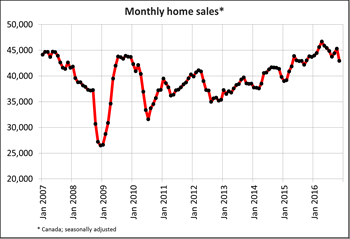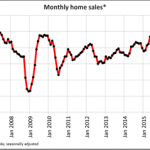Canadian home sales cool in November
Ottawa, ON, December 15, 2016 – According to statistics released today by The Canadian Real Estate Association (CREA), national home sales were down on a month-over-month basis in November 2016.
Highlights:
- National home sales fell 5.3% from October to November.
- Actual (not seasonally adjusted) activity remained 1.6% above levels in November 2015.
- The number of newly listed homes edged down 0.4% from October to November.
- The MLS® Home Price Index (HPI) in November was up 14.4% year-over-year (y-o-y).
- The national average sale price climbed 7.3% y-o-y in November.
 The number of homes trading hands via Canadian MLS® Systems declined 5.3 percent month-over-month in November 2016. This represents the largest monthly decline in activity since August 2012. As a result, the number of homes changing hands now stands at the lowest level since September 2015.
The number of homes trading hands via Canadian MLS® Systems declined 5.3 percent month-over-month in November 2016. This represents the largest monthly decline in activity since August 2012. As a result, the number of homes changing hands now stands at the lowest level since September 2015.
Activity was down on a month-over-month basis in about two-thirds of all local markets, including Canada’s most active markets.
“November was the first full month in which the expanded stress-test was in effect for home buyers with less than a twenty percent down payment,” said CREA President Cliff Iverson. “The government’s newly tightened mortgage regulations have dampened a wide swath of housing markets, including places not targeted directly by the government’s latest regulatory measures. The extent to which they pushed first-time home buyers to the sidelines varies among housing markets. All real estate is local, and REALTORS® remain your best source for information about sales and listings where you live or might like to in the future.”
“Canadian housing market results for November suggest that Canada’s housing sector is unlikely to be as strong a source for economic growth as compared to before mortgage regulations were recently tightened,” said Gregory Klump, CREA’s Chief Economist. “Housing activity generates a lot of spin-off spending, which makes its weakened prospects an additional source of uncertainty as regards the outlooks for Canadian economic and job growth.”
Actual (not seasonally adjusted) sales activity held 1.6 percent above where it stood in November 2015 – the smallest year-over-year increase since October 2015. Y-o-y activity gains in the Greater Toronto Area (GTA) and environs were offset by declines in B.C.’s Lower Mainland.
The number of newly listed homes edged down 0.4 percent in November 2016 compared to October. New listings were up from the previous month in close to half of all local markets, led by the GTA but offset by declines in B.C.’s Lower Mainland.
The national sales-to-new listings ratio declined to 59.8 percent in November compared to 62.9 percent in October.
A sales-to-new listings ratio between 40 and 60 percent is generally consistent with balanced housing market conditions, with readings below and above this range indicating buyers’ and sellers’ markets respectively.
The ratio was above 60 percent in almost half of all local housing markets in November, the vast majority of which are located in British Columbia, in and around the Greater Toronto Area and across Southwestern Ontario. In Greater Vancouver, the ratio has moved out of sellers’ market territory and into the mid-50 percent range.
The number of months of inventory is another important measure of the balance between housing supply and demand. It represents the number of months it would take to completely liquidate current inventories at the current rate of sales activity.
There were 4.8 months of inventory on a national basis at the end of November 2016 – up from a six-year low of 4.5 months in October, and the highest level since March 2016.
The tight balance between housing supply and demand in Ontario’s Greater Golden Horseshoe region is without precedent (including the GTA, Hamilton-Burlington, Oakville-Milton, Guelph, Kitchener-Waterloo, Cambridge, Brantford, the Niagara Region, Barrie and nearby cottage country). In November, the number of months of inventory ranged between one and two months in many of these housing markets, and stood below one month in the Durham Region, Orangeville, Oakville-Milton, Kitchener-Waterloo and Cambridge.
 The Aggregate Composite MLS® HPI rose by 14.4% y-o-y in November 2016. This is down from 14.6% in October and reflects a slowdown in single family home price appreciation.
The Aggregate Composite MLS® HPI rose by 14.4% y-o-y in November 2016. This is down from 14.6% in October and reflects a slowdown in single family home price appreciation.
Benchmark prices for two-storey single family homes and townhouse/row units posted the biggest y-o-y gains in November 2016 (16.3% and 16.0% respectively). Price increases were not far behind for one-storey single family homes (13.7%) and apartment units (11.5%).
While home prices rose on a y-o-y basis in 9 of the 11 markets tracked by the MLS® HPI, gains continued to vary widely.
The Fraser Valley (+29.7%) posted the largest y-o-y gain in November, while gains of around 20% were recorded in Greater Vancouver, Victoria and Greater Toronto (+20.5%, +20.6% & +20.3%, respectively). Vancouver Island also registered a double-digit increase in home prices (+16.8% y-o-y).
By contrast, home prices were down 4% y-o-y in Calgary, and edged lower by 1.2 percent y-o-y in Saskatoon. As a result, home prices are off their 2015 peaks in these markets by 5.5% and 3.9% respectively.
Meanwhile, home prices posted y-o-y gains in Regina (+5.4%), Ottawa (+3.4%), Greater Montreal (+3.1%) and Greater Moncton (+3.5%). (Table 1)
The MLS® Home Price Index (MLS® HPI) provides the best way of gauging price trends because average price trends are prone to being strongly distorted by changes in the mix of sales activity from one month to the next.
The actual (not seasonally adjusted) national average price for homes sold in November 2016 rose 7.3% y-o-y to $489,591.
The national average price continues to be pulled upward by sales activity in Greater Vancouver and Greater Toronto, which remain two of Canada’s tightest, most active and expensive housing markets.
That said, Greater Vancouver’s share of national sales activity has diminished considerably of late, giving it less upward influence on the national average price. Even so, the average price is reduced by almost $130,000 to $361,260 if Greater Vancouver and Greater Toronto sales are excluded from calculations.
– 30 –
PLEASE NOTE: The information contained in this news release combines both major market and national sales information from MLS® Systems from the previous month.
CREA cautions that average price information can be useful in establishing trends over time, but does not indicate actual prices in centres comprised of widely divergent neighbourhoods or account for price differential between geographic areas. Statistical information contained in this report includes all housing types.
MLS® Systems are co-operative marketing systems used only by Canada’s real estate Boards to ensure maximum exposure of properties listed for sale.
The Canadian Real Estate Association (CREA) is one of Canada’s largest single-industry trade associations, representing more than 115,000 REALTORS® working through some 90 real estate Boards and Associations.
Further information can be found at http://crea.ca/statistics.
For more information, please contact:
Pierre Leduc, Media Relations
The Canadian Real Estate Association
Tel.: 613-237-7111 or 613-884-1460
E-mail: pleduc@crea.ca






Leave a Reply
Want to join the discussion?Feel free to contribute!